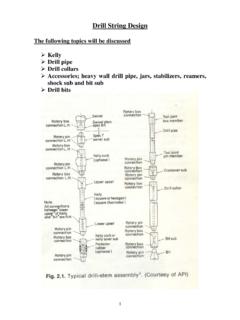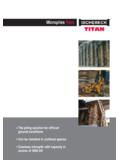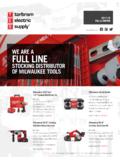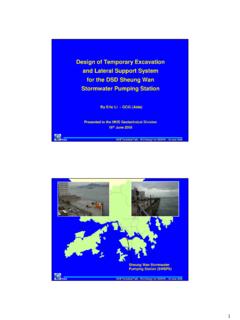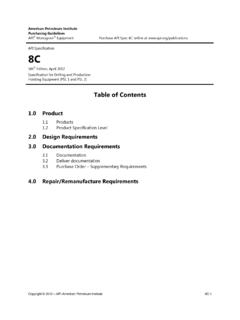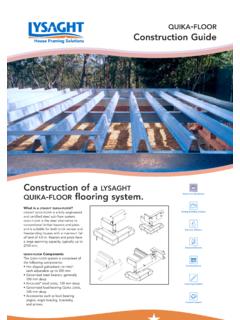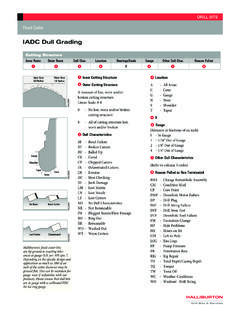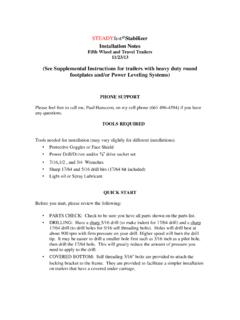Transcription of Peter Aird. Drilling Consutlant. BP Norge. - Drill Science
1 Assessing Geo-Hazards. Peter Aird. Drilling Consutlant. BP Norge. Table of contents. TABLE OF CONTENTS.. 2 INTRODUCTION .. 3 SHALLOW GEO HAZARDS.. 3 SUB SURFACE & SEABED OPERATIONAL HAZARDS .. 9 SURVEY METHODS AND 18 RULES OF THUMB .. 27 SHALLOW GAS RISK STATEMENTS .. 28 SHALLOW GAS DEFINITIONS .. 28 SHALLOW GAS INTERPRETATION GUIDE POINTS.. 29 APPENDIX 1 .. 30 A TYPICAL OPERATOR S SHALLOW GAS POLICY.. 30 APPENDIX 1.. 31 NORWEGIAN PETROLEUM DIRECTORATES (NPD) REGULATIONS .. 31 Introduction This document is intended for use by Drilling personnel engaged in the evaluation of geo hazards through all phases of the well delivery processes in both exploration, appraisal and development wells.
2 Pre-data acquisition shallow seismic/site-survey review well planning well construction well execution phases . Its purpose is to ensure that hazards are recognised and analysed with risks determined so that well design, wellbore and equipment integrity, and Drilling operational procedures can be executed at risks as low as reasonably practicable, meeting well objectives, in compliance to both company policy and regulatory requirements that exist. Shallow Geo Hazards. If geo-hazards exist in the subsurface sediments, they must be identified, ranked with all associated risks determined, at the earliest opportunity in the well planning process. Only such a process can then ensure that best operational guidelines and contingencies will exist to prevent and eliminate risks and operational loss to levels as low as safely practicable.
3 Shallow geo-hazards would include, but are not limited to: Sub Surface & seabed conditions. Incompetent sediments. Slump and scour features. Faulting and glide planes to shallow depths. Shallow water & gas flow pockets & reservoirs. Mud volcanoes. Gas hydrates and moulds. Over pressured zones. Soft seabed conditions Mud slides Low fracture pressures Shallow prospects Addressing hazards Geo-hazards such as shallow water flows, shallow gas, hydrates, mud volcanoes, seabed topography, and slump-fault features are key topics for Drilling professionals and earth scientists. The three main concerns offshore operators must deal with are; 1.
4 Site specific selection, for lowest risk. 2. surface and subsurface geo-hazard avoidance, 3. geo-hazard mitigation. With respect to these concerns, a trend towards multidisciplinary team working, involving Drilling engineers, geologists, petro-physicists, geophysicists, etc. has provided the offshore rig team members with much more open networks of information, allowing for better location selection and improved decision making. Drillers should take note however that as while preparatory work for offshore site selection continues to take advantage of sophisticated sensing technologies and data packages. Operators have yet to fully develop and integrate effective processes to pay sufficient and more attended detail to the threat of near-surface geo-hazards ( mud line through to surface and even intermediate casing points), perhaps even more so in the deep open water environments than often paid to the lower pay zones.
5 Why? because historic data clearly testifies that this is where significant operational loss exists. Lost time events in the shallow formations often resulting in well-control situations, lost wellheads, poor cement jobs, rig instability, damaged casing, re-entry problems, even abandonment, and expensive remedial action to ensue. Shallow water flows (SWFs) on a recent well study of Gulf of Mexico deepwater wells, have cost an estimated $165 million in remedial actions ("shallow" in this context refers to the subsurface, not water depth). On such locations, operators spent 65% of their time performing remedial work, the remainder on prevention measures. Just as important, dealing with hydrostatic and formation pressure relationships has also become a key subject area.
6 "SWF for example is a key problem in narrow margin Drilling , which arises from a combination of formation over-pressure and low formation strength." " Drilling shallow, soft, and over pressured formations and controlling ECDs [equivalent circulating densities] within a tight margin, is no simple proposition, given margins as low as to ppg," If pore pressures are not therefore not determined, understood and mitigated against, the shallow formations will flow, leading to washouts, ineffective cementing, formation compaction, damaged casing, and hole re-entry problems. Note: SWF indicators, risks and problem-solving strategies, because of their importance in successfully meeting well objectives in deep open water operations, require addressed in much more descript detail, in a separate document.
7 Data processing Data used to identify geo-hazard occurrences include both conventional and reprocessed 3D seismic, 2D and 3D high-resolution seismic, seismic velocity data, analog site surveys, and core samples. 3D seismic data is used for improving understanding of the environment of deposition and sedimentological units and high-resolution 3D can be used to depict "vivid images" of the sea bottom. In exploration plays with limited well data, seismic velocity data can be also be used to detect overpressure zones and hydrates. In additional, analog site survey data, which include high-frequency data acquired from echo sounding, side-scan sonar s, and sub bottom profiling, can provide accurate bathymetry maps, seafloor mosaics, indications of seafloor gas, and shallow fault detection.
8 Finally, digital site-survey data can result in improved imaging of the subsurface near the seafloor, leading to improved fault and thin-bed mapping. Unfortunately, although these data consist of higher frequencies than 3D seismic, there is a disadvantage of being unable to resolve the 3D nature of the hazards. When used in conjunction with 3D data, they may aid in the interpretation, however. With such data, over pressurised (water flow/gas) pockets can be depicted by seismic data and attribute analysis that may produce anomalous high amplitudes and reflection time sags. Similarly, indications of hydrates can be found with seismic data, attribute, and velocity analysis.
9 Mud volcanoes and pock marks, on the other hand, can be depicted through 3D seafloor visualisations and seismic sections. Finally, moreover, seafloor debris can be seen with side-scan sonar, while slumps and faults can be shown as breaks in seismic reflections using 2D and 3D seismic sections and time slices. Geo-technical assessment. Geo-technical studies may also be required especially in deep open water well planning operations to assure that in execution, the placement of the conductor and surface string designs are well founded, as it is this seabed-supported structure which must sustain loading of some nature. In fact, the loading regime acting on a well conductor is complex, varies throughout the conductor's life, and is often not afforded as much attention as is warranted.
10 One of the key considerations therefore when planning and installing conductors is the need to avoid geo-hazards - or to design around them. over-pressured shallow formations, boulders, excessively hard or soft soils or sensitive soils, faults and slopes. Geo-technics assist to identify, avoid, determine and/or design around most of these hazards. when driving conductors in hard, boulder-strewn ground, often encountered in the North Sea. Geo-technical models can allow a minimum conductor shoe thickness to be specified in order to resist tip buckling. The conductor can then be drilled out for the first inner casing without the risk of the Drill string getting stuck in a deformed conductor.
